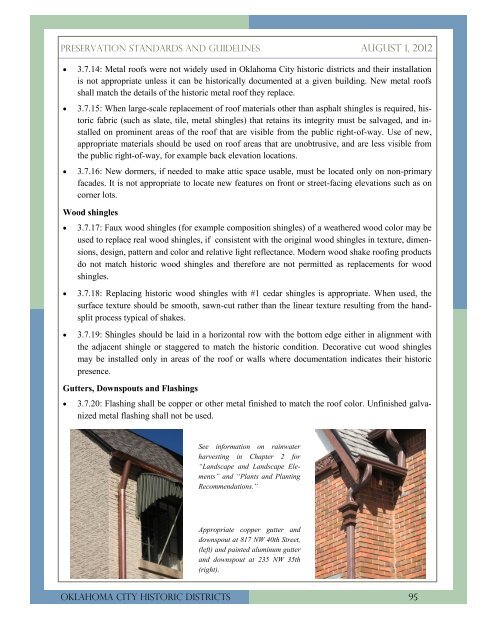Guidelines - City of Oklahoma City
Guidelines - City of Oklahoma City
Guidelines - City of Oklahoma City
Create successful ePaper yourself
Turn your PDF publications into a flip-book with our unique Google optimized e-Paper software.
Preservation Standards AND <strong>Guidelines</strong> August 1, 2012<br />
<br />
<br />
<br />
3.7.14: Metal ro<strong>of</strong>s were not widely used in <strong>Oklahoma</strong> <strong>City</strong> historic districts and their installation<br />
is not appropriate unless it can be historically documented at a given building. New metal ro<strong>of</strong>s<br />
shall match the details <strong>of</strong> the historic metal ro<strong>of</strong> they replace.<br />
3.7.15: When large-scale replacement <strong>of</strong> ro<strong>of</strong> materials other than asphalt shingles is required, historic<br />
fabric (such as slate, tile, metal shingles) that retains its integrity must be salvaged, and installed<br />
on prominent areas <strong>of</strong> the ro<strong>of</strong> that are visible from the public right-<strong>of</strong>-way. Use <strong>of</strong> new,<br />
appropriate materials should be used on ro<strong>of</strong> areas that are unobtrusive, and are less visible from<br />
the public right-<strong>of</strong>-way, for example back elevation locations.<br />
3.7.16: New dormers, if needed to make attic space usable, must be located only on non-primary<br />
facades. It is not appropriate to locate new features on front or street-facing elevations such as on<br />
corner lots.<br />
Wood shingles<br />
<br />
<br />
<br />
3.7.17: Faux wood shingles (for example composition shingles) <strong>of</strong> a weathered wood color may be<br />
used to replace real wood shingles, if consistent with the original wood shingles in texture, dimensions,<br />
design, pattern and color and relative light reflectance. Modern wood shake ro<strong>of</strong>ing products<br />
do not match historic wood shingles and therefore are not permitted as replacements for wood<br />
shingles.<br />
3.7.18: Replacing historic wood shingles with #1 cedar shingles is appropriate. When used, the<br />
surface texture should be smooth, sawn-cut rather than the linear texture resulting from the handsplit<br />
process typical <strong>of</strong> shakes.<br />
3.7.19: Shingles should be laid in a horizontal row with the bottom edge either in alignment with<br />
the adjacent shingle or staggered to match the historic condition. Decorative cut wood shingles<br />
may be installed only in areas <strong>of</strong> the ro<strong>of</strong> or walls where documentation indicates their historic<br />
presence.<br />
Gutters, Downspouts and Flashings<br />
<br />
3.7.20: Flashing shall be copper or other metal finished to match the ro<strong>of</strong> color. Unfinished galvanized<br />
metal flashing shall not be used.<br />
See information on rainwater<br />
harvesting in Chapter 2 for<br />
“Landscape and Landscape Elements”<br />
and “Plants and Planting<br />
Recommendations.”<br />
Appropriate copper gutter and<br />
downspout at 817 NW 40th Street,<br />
(left) and painted aluminum gutter<br />
and downspout at 235 NW 35th<br />
(right).<br />
<strong>Oklahoma</strong> <strong>City</strong> Historic Districts 95
















